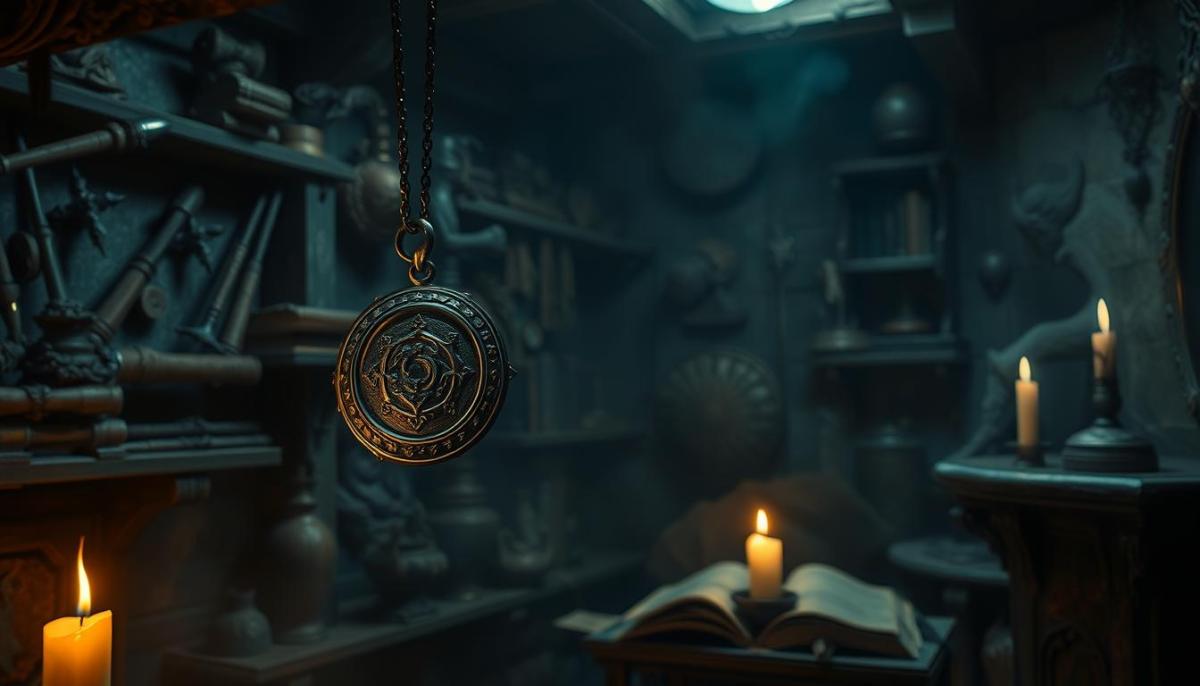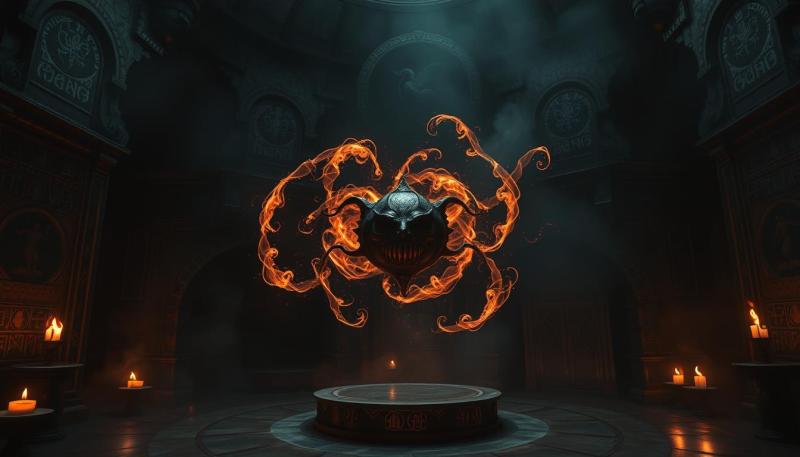Ever wondered what keeps a dark wizard alive long after their body perishes? In J.K. Rowling's beloved series, the answer lies in mysterious soul fragments hidden within ordinary objects. These cursed items – central to the battle between good and evil – hold the key to understanding one of fiction's most chilling quests for immortality.
The concept of these soul containers first emerges in Harry Potter and the Half-Blood Prince, though their influence spans the entire saga. As dark magical objects, they represent the ultimate corruption of magic – splitting one's essence through unspeakable acts. Their existence explains why certain adversaries keep returning, even when defeat seems certain.
What makes them so fascinating isn't just their magical properties, but what they reveal about human nature. Through Tom Riddle's twisted journey, we see how fear of death can drive someone to unimaginable extremes. The series' exploration of this theme – particularly in Chamber of Secrets and later installments – creates a layered conflict that goes beyond typical good-versus-evil tropes.
Key Takeaways
- Soul fragments stored in objects grant dangerous immortality
- Creation requires committing ultimate acts of evil
- Six hidden items fuel the Dark Lord's survival
- Specific destructive methods are needed for elimination
- Symbolize the series' exploration of mortality and corruption
As we peel back layers of wizarding lore together, you'll discover how these cursed items connect to major plot points – from basilisk-laden chambers to sentimental heirlooms. Ready to uncover what makes them both fascinating and terrifying?
Introduction to Horcruxes in Harry Potter
What if immortality came at the cost of your humanity? In magical realms, this question finds its answer through twisted soul magic that defies natural laws. These cursed artifacts don't just store memories – they trap pieces of a living soul through unspeakable acts.
When Objects Become Soul Prisons
A Horcrux isn't just a magical container – it's a violation of life's natural cycle. Created through murder, these items anchor part of the creator's essence to the physical world. Tom Riddle first explored this dark art during his Hogwarts years, using the Chamber of Secrets incident to test his theories.
The infamous diary demonstrates how these soul fragments manipulate others. When Ginny Weasley poured her fears into its pages, the object nearly drained her life force to resurrect its creator. This early experiment proved the concept's viability, pushing Riddle toward more ambitious plans.
| Horcrux Item | Creation Method | Book vs Movie Differences |
|---|---|---|
| Tom Riddle's Diary | Myrtle Warren's murder | Book shows more possession details |
| Marvolo Gaunt's Ring | Tom Riddle Sr.'s death | Movie skips curse effects on Dumbledore |
| Slytherin's Locket | Muggle tramp's killing | Film adds spectral Voldemort imagery |
The Dark Lord's Path to Eternal Existence
Lord Voldemort didn't just want to cheat death – he sought to redefine magical limits. By splitting his soul seven ways, he created multiple anchors to the living world. Each fragment reflected his twisted values, hidden in objects tied to wizarding history like the Hufflepuff Cup.
This pursuit warped his physical form and psyche. The more soul pieces he created, the less human he became – a chilling lesson about power's corrupting influence. His obsession ultimately created vulnerabilities that heroes exploited, proving that true strength lies in unity, not division.
Origins and Creation of Horcruxes
How does one fracture the very essence of their being? The answer lies in ancient, forbidden rituals that warp magic’s natural purpose. Creating a soul anchor isn’t just dangerous—it’s a fundamental betrayal of life itself, condemned even by the strictest ministry magic regulations.
The Dark Magic Behind Soul Splitting
Splitting the soul requires more than spells—it demands an act so vile it tears apart the caster’s humanity. Ancient texts describe rituals involving basilisk venom-infused daggers and incantations lost to modern wizardry. The ministry magic archives reveal failed attempts to replicate these processes, often ending in madness or death.
Take Bertha Jorkins, a Ministry employee whose disappearance tied directly to dark rituals. Her fate shows how easily knowledge of soul manipulation corrupts even cautious minds. Modern practitioners face similar risks, as the ministry magic division actively hunts those dabbling in these arts.
The Role of Murder in Horcrux Creation
Murder isn’t just a step—it’s the catalyst. Killing fractures the soul, creating a wound dark magic exploits. This irreversible damage explains why Bellatrix Lestrange guarded her cursed vault so fiercely; she understood the cost of such acts.
The infamous Potter chamber incident, where a teenage Tom Riddle first tested these theories, proves how early this corruption begins. Each murder strips away empathy, leaving the creator less human—a truth echoed in Bellatrix’s fanatical loyalty to her master.
| Dark Magic Element | Purpose | Consequence |
|---|---|---|
| Murder | Soul fracture | Irreversible spiritual decay |
| Basilisk Venom | Ritual component | Accelerates dark magic’s effects |
| Ministry Bans | Control dark arts | Limited enforcement success |
These practices don’t just risk the caster’s soul—they ripple through generations. The Potter chamber’s legacy and Bertha’s tragedy remind us: some magic should forever remain buried.
Exploring the harry potter horcrux in Depth
What happens when dark magic backfires spectacularly? The answer lies in an unprecedented magical phenomenon—a living person becoming a soul anchor. This twist of fate binds two destinies while challenging everything we know about immortality.
Case Study: The Boy With a Scar
That fateful Halloween night created more than a legend—it forged an unbreakable soul tether. When the Killing Curse rebounded, a fragment of the Dark Lord's essence latched onto the only living thing in the room. This accidental bond gave the young wizard abilities no textbook could explain.
Through his scar, he gained Parseltongue skills and disturbing visions. These weren't mere side effects—they were direct conduits to another mind. Unlike intentional soul anchors stored in objects like the Gaunt ring, this living connection defied all known magical laws.
Immortality’s Double-Edged Sword
Soul anchors cheat death by freezing moments in time. The Slytherin locket and Hufflepuff cup represent frozen fragments of existence—trapped power waiting to be reclaimed. But true immortality? It comes at the cost of fractured identity.
Consider the contrast:
| Intentional Anchors | Accidental Bond |
|---|---|
| Planned through ritual | Created through chaos |
| Stored in objects | Resides in living flesh |
| Requires destruction | Demands sacrifice |
This twist adds profound emotional weight. The protagonist’s journey isn’t just about defeating evil—it’s about reclaiming his own soul. As Dumbledore noted, “Destiny rarely follows our plans”—a truth that reshapes our understanding of life, death, and legacy.
Breakdown of Voldemort’s Horcruxes
Behind every cursed object lies a story of twisted ambition. Let’s dissect the six soul fragments that fueled a dark wizard’s quest for eternal life, revealing how ordinary items became weapons against mortality itself.
Tom Riddle’s Diary: Ink-Stained Corruption
This innocent-looking book hid the first fragment, created through Myrtle Warren’s murder. Unlike other objects, it actively manipulated Ginny Weasley in Chamber of Secrets. Harry destroyed it with a basilisk fang – a poetic way to end the monster’s legacy.
Marvolo Gaunt’s Ring: Family Curse Unleashed
The black-stoned heirloom connected to the dark wizard’s father carried a deadly trap. Dumbledore fell victim to its curse in Half-Blood Prince, though films downplay this subplot. Only the Sword of Gryffindor could shatter its dark magic.
Salazar Slytherin’s Locket: Soul-Sucking Heirloom
This serpent-adorned relic drained hope from anyone wearing it. The book version shows Ron’s pivotal destruction scene – missing from films – where the sword proves its worth against dark enchantments.
Harry Potter Forever Postage Stamps Booklet
Celebrate your love for the Wizarding World with these enchanting postage stamps that bring the magic of Harry Potter to your mail
Product information
$32.50 $29.95
Product Review Score
4.49 out of 5 stars
140 reviewsProduct links
Hogwarts’ Stolen Legacy: Cup & Diadem
Helga Hufflepuff’s cup and Rowena Ravenclaw’s diadem symbolized stolen heritage. Destroyed through fiendfyre and basilisk fang respectively, their fates highlight different ways to combat dark magic. The diadem’s movie destruction simplifies the book’s intricate Room of Requirement sequence.
| Object | Destruction Method | Book vs Film Difference |
|---|---|---|
| Diary | Basilisk Fang | Film shows ink-blood effect |
| Ring | Sword of Gryffindor | Movie omits Dumbledore’s hand injury |
| Locket | Sword Stab | Book includes extended possession scene |
Symbolism and Narrative Importance of Horcruxes
Dark magic's true cost isn't measured in spells cast, but in what's sacrificed to wield it. These cursed objects represent more than immortality—they're mirrors reflecting humanity's deepest fears and flaws.
Immortality's Hollow Promise
Creating a soul anchor demands more than murder—it requires abandoning one's humanity. Each act of soul-splitting leaves the creator less whole, as shown through the half-blood prince's transformation from gifted student to soulless tyrant.
The sword of Gryffindor becomes poetic justice in this context. Forged from goblin silver that absorbs strengths, it literally turns dark magic against itself when destroying anchors like the marvolo gaunt ring.
"There is nothing worse than death, Dumbledore!" snarled Voldemort.
Half-Blood Prince
Fractured Soul, Fractured Identity
Voldemort's choice of anchors reveals his twisted self-image. The marvolo gaunt ring symbolizes ancestral pride, while Ravenclaw's diadem reflects intellectual arrogance. Each object represents stolen legacy rather than earned power.
| Horcrux Object | Symbolic Meaning | Destruction Method |
|---|---|---|
| Diary | Manipulation of truth | Basilisk fang |
| Gaunt Ring | Obsession with blood purity | Sword of Gryffindor |
| Locket | Corruption of heritage | Sword of Gryffindor |
Through the half-blood prince's backstory, we see how soul fragmentation warps perception. Tom Riddle's journal entries in Half-Blood Prince show his gradual dehumanization—a stark contrast to the sword's role in restoring balance.
Impact of Horcrux Destruction on Characters and Plot
Destruction isn't just an act—it's a transformation. Every shattered soul fragment reshaped both the wizarding world and those brave enough to wield basilisk fangs or fiery spells. Let's explore how breaking these dark anchors altered destinies and tipped scales in the Deathly Hallows climax.

The Role of the Sword of Gryffindor
Forged by goblins and imbued with basilisk venom, this legendary blade became the ultimate Horcrux killer. Its first strike against Riddle's diary in Chamber of Secrets foreshadowed its greater purpose. By Deathly Hallows, it destroyed both Slytherin's locket and Nagini—proving that true courage outlasts dark magic.
"It's a curious thing, Harry, but perhaps those who are best suited to power are those who have never sought it."
Deathly Hallows
$27.10
$24.80
4.71 out of 5 starsHarry Potter Impossible 1000-Piece Jigsaw Puzzle
Challenge yourself with a magical journey through the enchanting world of Harry Potter!
Product information
Product Review Score
Product links
Character Development Triggered by Loss
Each destroyed soul container exacted an emotional toll. Neville's fiery destruction of Nagini symbolized his growth from timid student to Order of the Phoenix leader. Ron's locket-stabbing moment revealed buried insecurities—and the strength to overcome them.
| Destroyed Horcrux | Character Impact | Strategic Shift |
|---|---|---|
| Hufflepuff's Cup | Hermione's resolve hardened | Gringotts break-in exposed Death Eater operations |
| Ravenclaw's Diadem | Luna's wisdom guided destruction | Hogwarts battle became winnable |
| Nagini | Neville embraced leadership | Final duel became inevitable |
The Order of the Phoenix suffered devastating losses—Fred's death, Lupin's sacrifice—but each loss fueled their determination. As Voldemort's anchors fell, his instability grew, proving that divided souls can't sustain true power. The wizarding world's eventual victory wasn't just about destroying objects—it was about healing collective trauma through shared courage.
Behind the Scenes: Books versus Movies on Horcruxes
Adapting magical lore for the screen often means making tough creative cuts. Let’s explore how film versions streamlined soul-container lore—sometimes at the cost of deeper character moments.
Key Omissions and Adaptation Choices
The first horcrux’s destruction shows striking differences. While both book and film use basilisk fangs, the movie adds dramatic ink-blood effects during the diary scene. This visual flair simplifies the complex magical corrosion described in print.
Ginny Weasley’s connection to the diary gets minimized on screen. The books show her gradual possession through handwritten confessions—a subplot that deepens her character. Films reduce this to brief tense moments, losing her emotional arc.
| Element | Book Version | Movie Changes |
|---|---|---|
| Marvolo Gaunt’s Ring | Detailed memory sequences | Skips curse’s impact on Dumbledore |
| Fiendfyre Scene | Vincent Crabbe casts spell | Gregory Goyle replaces character |
| Sword Usage | Multiple using sword moments | Focuses on locket destruction |
Vincent Crabbe’s fiery end in the books carries symbolic weight—his dark magic consumption contrasts with heroes’ sacrificial acts. Movies swap him for Goyle, losing this nuanced parallel.
The Marvolo Gaunt family history suffers most in translation. Tom Riddle’s ancestry revelations, crucial for understanding his obsession with purity, get reduced to brief flashbacks. This omission weakens the thematic punch of heirlooms becoming soul prisons.
Despite these cuts, films excel in visual storytelling. Using sword of Gryffindor for locket destruction gains emotional heft through actor performances. Yet book fans still miss details like the first horcrux’s psychological manipulation tactics.
Ultimately, both formats have strengths. Movies create iconic moments, while books preserve Ginny Weasley’s agency and Vincent Crabbe’s cautionary tale. Your preference depends on what you value more—cinematic spectacle or literary depth.
Horcruxes and the Legacy of Dark Magic
True evil never truly dies—it leaves scars etched into history. Even after the last horcruxes destroyed, their dark echoes linger like cursed smoke. Let’s explore how these soul fragments reshaped magical society long after their physical forms vanished.

Long-Term Effects on the Wizarding World
The shadow of Salazar Slytherin’s ideology stretched centuries beyond his death. His obsession with blood purity became a blueprint for destruction when followers like Hepzibah Smith’s killer weaponized heirlooms. Smith’s murder to steal Helga Hufflepuff’s cup wasn’t just theft—it corrupted her legacy into a tool for terror.
Consider the aftermath:
| Aspect | Pre-Destruction | Post-Destruction |
|---|---|---|
| Magical Education | Ignored dark magic history | Mandatory soul magic ethics courses |
| Ministry Policies | Lax artifact regulation | Strict soul container bans |
| Public Trust | Fear of dark wizard resurgence | Collective healing initiatives |
The attempt to kill Harry created unexpected ripples too. Survivors of such attacks formed support networks, echoing how Muggle-born witches and wizards reclaimed spaces once tainted by prejudice. Even Hogwarts’ walls whisper lessons from this era—the Chamber of Secrets now hosts seminars on combating dark ideologies.
Smith’s tragic end and Helga Hufflepuff’s corrupted cup remind us: objects absorb their owners’ stories. Museums now display these relics with cautionary plaques, turning symbols of hate into teachable moments. As the last generation who fought Salazar Slytherin’s heirs ages, their oral histories become sacred texts against repetition.
Dark magic’s legacy isn’t just about curses—it’s about how we rebuild. Every repaired wand and healed scar proves light persists where shadows once ruled.
Conclusion
True power lies not in what we preserve, but in what we’re willing to lose. Through exploring soul fragments like the Gaunt Ring and Slytherin Locket, we’ve seen how dark magic corrupts legacies into weapons. These objects aren’t just plot devices—they’re mirrors reflecting humanity’s battle between fear and courage.
Characters like Neville Longbottom embody this struggle. His fiery destruction of Nagini in the Room of Requirement wasn’t just heroic—it symbolized reclaiming agency from darkness. Every attempt to create Horcrux anchors reveals a tragic truth: immortality fractures identity far more than death ever could.
Revisiting the series, notice how locations like the Room of Requirement shift roles—from hiding places to battlegrounds. The cost of dark magic lingers long after curses break, reminding us that true strength emerges through unity, not division.
Next time you dive into this world, ask yourself: What would you sacrifice to protect what matters? The answer might just change how you see every choice—from Tom Riddle’s first murder to Neville Longbottom’s final stand. Light persists where shadows fall, but only if we dare to wield it.
Gryffindor Hooded Bathrobe for Harry Potter Fans
Wrap yourself in the cozy spirit of Gryffindor while enjoying magical moments at home
Product information
$79.99
Product Review Score
4.26 out of 5 stars
195 reviews









